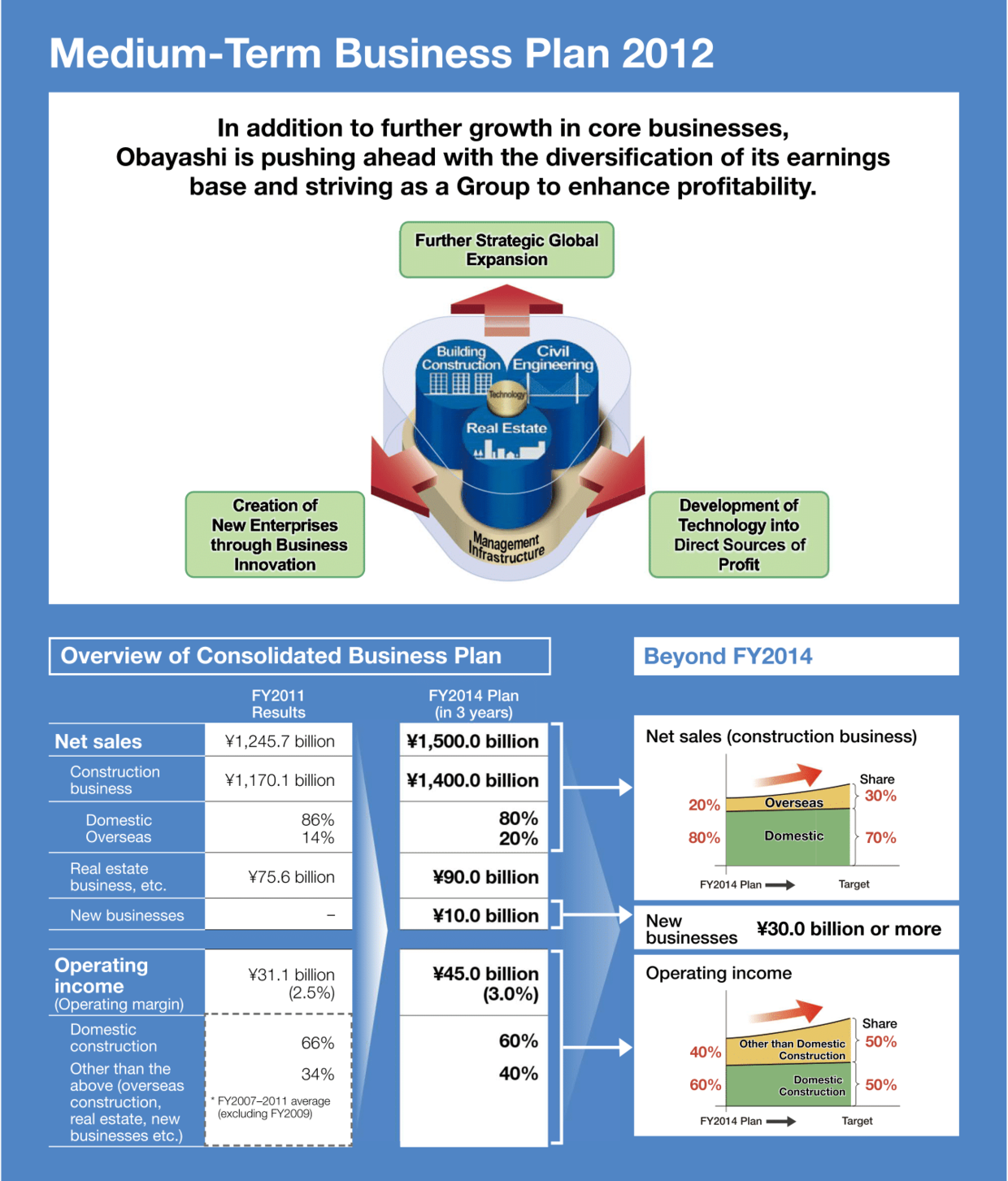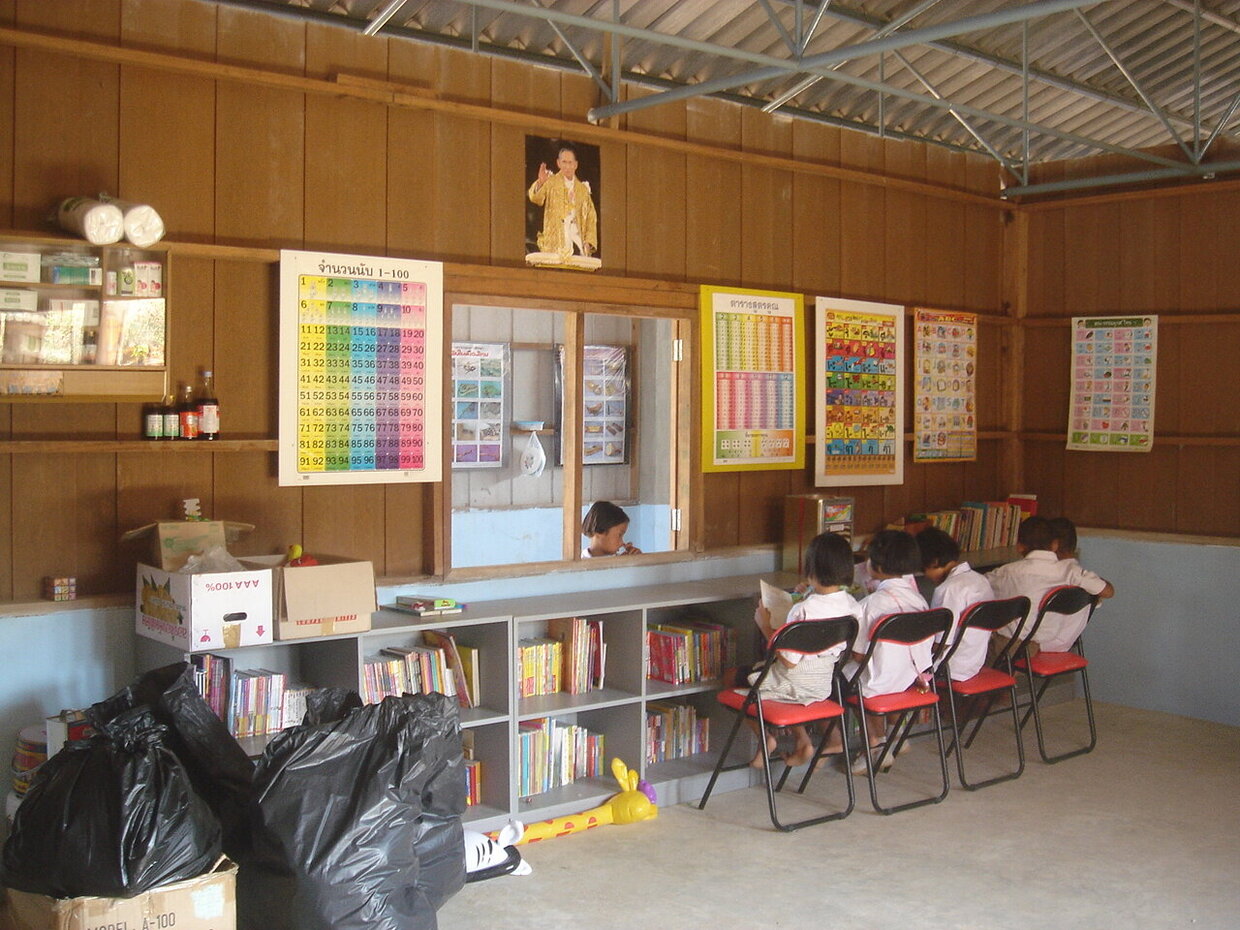Diversifying the Earnings Base
Establishment of the Medium-Term Business Plan ’12
The company implemented a variety of initiatives based on its Medium-Term Business Plan 2008, a five-year plan that started in FY2009.3. However, this period saw a marked deterioration in orders due to the 2008 global financial crisis, as well as a succession of events, including the Great East Japan Earthquake and the prolonged historic appreciation of the yen, that significantly affected the company’s business. In order to transform its earnings structure to adapt flexibly and robustly to such drastic changes in the business environment, the company commenced the Medium-Term Business Plan ’12 (FY2013.3–FY2015.3) for the three-year period from FY2013.3 prior to the conclusion of the final fiscal year of the Medium-Term Business Plan 2008.
The Medium-Term Business Plan ’12 set out the goal of achieving further growth in core businesses, along with diversifying the earnings base to enhance Group profitability.
To promote further growth in core businesses, the company shared information and pooled technologies and assets to strengthen collaboration within the Group and improve the profitability of the domestic construction business. In the domestic civil engineering business, the company engaged in social infrastructure projects for disaster prevention and mitigation which provide for a safe and secure society. In the real estate business, the Obayashi Group came together to enhance a stable earnings base composed of mainly the property leasing business and made investments for business expansion. The company increased leasing business profits by continuing to invest in office buildings, mainly in the Tokyo and Osaka metropolitan areas, and boosted profit by flexibly investing in the property for sale business. Through these efforts, the company aimed to develop the real estate business into a core area alongside the construction business and secure stable earnings.
To diversify the earnings base, the company focused on three basic policies: “further strategic global expansion” in selected regions and business domains; “creation of new enterprises through business innovation” involving commercializing the technology and ingenuity built up within the company through new business models; and “development of technology into direct sources of profit” by transforming technology, which had functioned as a source of competitiveness in the construction business.
In terms of management targets, the company prioritized consolidated operating margin as an indicator of profitability strengthening. It aimed to achieve a 3 percent margin and to raise the return on equity (ROE) to 8 percent or higher by FY2015.3, the final fiscal year of the plan.

Promoting Diversification of the Earnings Base
The Medium-Term Business Plan ’12 promoted further growth in core businesses as well as diversification of the earnings base by advancing into new business fields. In order to achieve this, the company set out the following three basic policies.
“Further strategic global expansion” was the first of the policies. The three regions of North America, Southeast Asia, and the Middle East as well as Oceania were identified as priority areas in the overseas construction business. The company assessed the regions from the perspective of risk management and selection and concentration of management resources, and expanded business strategically in ways suited to the characteristics of each region. The plan set a target of increasing the overseas net sales ratio in the construction business to over 20 percent on a consolidated basis. In line with this goal, the company promoted a global workforce by hiring more foreign employees in Japan, among other initiatives.
The second policy, “creation of new enterprises through business innovation,” outlined the company’s efforts to seek commercialization of the technology and ingenuity built up within the Obayashi Group through new business models. The company’s entry into the renewable energy business is one example. Through Obayashi Clean Energy Corporation, founded in July 2012, it became the first company in the Japanese construction industry to promote energy generation through mostly solar, but also wind, biomass, geothermal, and small-scale hydroelectric power generation. The company also expanded its business into new fields, such as a new form of agriculture known as solar-powered plant factories.
The third policy, “development of technology into direct sources of profit” explored ways in which the company could obtain new earnings from technologies, which until then had been instrumental in helping win construction contracts. Obayashi aspired to achieve, for example, fee-based businesses that leveraged its technology, along with expanding the total coordination provided by its engineering business in the construction of factories and other production facilities. The company aimed to utilize the diverse technology and ingenuity accumulated within the Group to generate new profits.
In connection with the third policy, the Medical and Welfare Promotion Department (established in May 2006) was transferred from the Engineering Division to the Technology Division in April 2012 to strengthen sales support by demonstrating the superiority of Obayashi-developed technology.
Furthermore, in March 2014, the company sold Hyatt Regency Osaka (designed and built by Obayashi), which opened in 1994, and in September 2014, liquidated its operating company, HR Osaka, to withdraw from the hotel business. This management decision was made for the company to focus on other businesses, given that the hotel business continued to make losses and no synergy effects with its core business could be expected.
Obayashi Group’s Social Initiatives
The Obayashi Group is engaged in a variety of social contribution activities with “Global Environmental Responsibility,” “Disaster Readiness and Post-Disaster Reconstruction,” “Good Citizenship in Local Communities,” and “Inspiration for the Next Generation” as its main priorities.
At construction sites, the company not only offers tours but also conducts activities that utilize the characteristics and management resources of individual sites. As an example of such activity, during the construction of the Inagi Tunnel on the Shin-Tomei Expressway, the company collaborated with the project implementer, Central Nippon Expressway (NEXCO Central), and the government of Shinshiro City to protect rare aquatic life, including amago salmon and torrent catfish inhabiting the rivers in the construction zone, moving them outside of the zone (2011). The activity also served as an example of nature conservation education for young people and helped realize eco-friendly construction work.
At the construction site of the “Reconstruction Road” along the Sanriku Coast, employees of the company and the children of the local elementary school in Toni released 5,000 juvenile salmon in 2015. While the release of juveniles had been carried out since before the Great East Japan Earthquake, an Obayashi Corporation joint venture decided to participate in this community event to put on display the progress of its construction work. The JV offered its materials storage area along Katagishi River at the construction site as a place to release the juveniles. The activity offered the opportunity to show the progress of the construction work, and JV participants helped keep the children safe by guiding them to the riverbank and released the juveniles with the children.
Through its PFI projects, the company is involved is the development and operation of the Shimane Asahi Rehabilitation Program Center correctional facility, where it started a program in 2009 to raise puppies as potential guide dogs by inmates (trainees) in collaboration with the Japan Guide Dog Association and the Ministry of Justice’s Correction Bureau. This is the first such attempt in Japan aimed at fostering trainees’ sense of self-affirmation, empathy with others, sense of achievement, and sense of responsibility through activities that contribute to society. Since then, Obayashi has continued to build up its track record in this program.
Among the overseas Group companies, U.S. subsidiary Webcor is involved in volunteer activities to rebuild and renovate facilities for the elderly and children, such as nursing homes and Boy Scout facilities. Since 2007, Thai Obayashi has built libraries on local elementary school grounds and other locations and continues to donate books as part of its community outreach activities that are only possible by a construction company.
